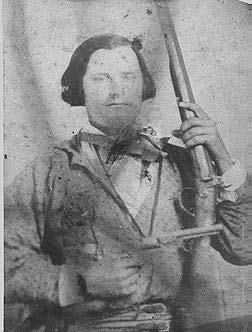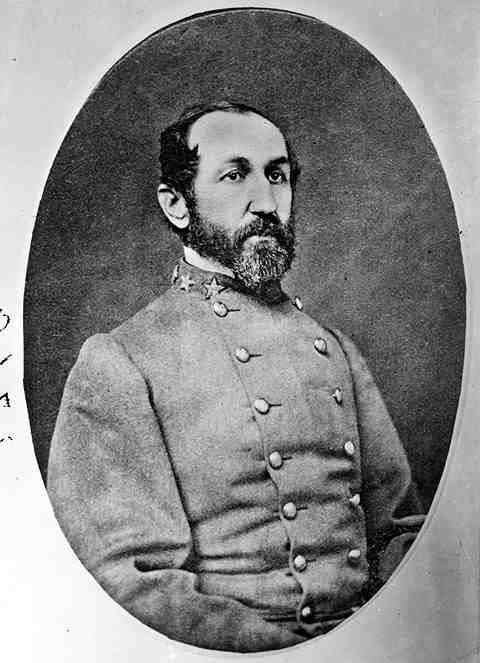
Photo Credit: Private Collection The Approach of War: Arms in Southern HandsWith Civil War beginning in April 1861, the South found itself unprepared for a long conflict. Prewar open-market purchases, combined with sizeable stocks that had accumulated over the years in state and local arsenals under the Militia Act of 1808, allowed the South to possess from 285,000 to 300,000 military firearms. This was an ample supply for a short war. Production of the modern rifle musket in the proceeding five years in the national armories at Springfield Armory and at Harper’s Ferry Armory had allowed older smooth-bored and rifled muskets as well as rifles to be transferred to state arsenals. In 1859-60, Springfield Armory alone transferred 104,000 such older arms to southern arsenals. These same weapons were among those rushed into the fight for the Confederacy. Still, most of the weapons available to the South were heavy, outdated arms and civilian arms like those seen beind held by Pvt. Hockensmith. 
Photo Credit: Library of Congress Arming the ConfederacySouthern arsenals had approximately 175,000 modern shoulder arms on hand at the beginning of the war. Of these, about 140,000 were smooth-bored, not including arms provided from private citizens. During the war, arms were supplied through manufacture, importation, and from the battlefield.The greater part of Confederate rifle production was in armories at Richmond, Virginia, and at Fayetteville, North Carolina. The Richmond Armory, led by Brig. Gen. Gorgas, used rifle musket-making machinery salvaged from the destruction of the federal Harper’s Ferry Armory following the first few weeks of the war. The Richmond Armory rifle musket was a close copy of the US rifle musket. Fayetteville Armory received machinery from Harper’s Ferry Armory for manufacturing a copy of the US Model 1841 rifle. Along with the machinery came many skilled former Harpers Ferry Armory workmen who added their skills to the Confederate war effort. By the end of the war in April 1865, an estimated 107,000 shoulder arms had been manufactured throughout the Confederacy. The Confederacy had precipitated a civil war at a time when the United States reigned as the leading firearms producer in the world, especially in the techniques of mass production and standardization of parts at Springfield Armory. With the exception of the machinery seized by Virginia state troops at Harper’s Ferry on April 17, 1861, most of the modern arms-making equipment and most of the raw materials were located in the industrialized North. While the North functioned with a system of well-defined federal powers, such was not the case in the Confederacy. Southern state leaders often assumed control of critical resources. In order to manufacture rifle muskets for the Confederacy, Gorgas had to get the Harper’s Ferry machinery away from the state of Virginia. The priority of Confederate states was the arming of local militias. With little cooperation from the states, Gorgas acquired the needed arms. His many sources included domestic manufacture, European purchases, captured weapons from Federal arsenals, and battlefield pick-ups. The Confederacy imported over 340,000 European arms. From the Collection of Springfield ArmorySpringfield Armory NHS houses the largest collection of Confederate shoulder arms in the world. Most of these weapons were added to the collection in the first six months of 1866 from former Confederate arsenals on orders of the US Ordnance Department. A large proportion of the cache is made up of former Federal weapons stored in Southern arsenal prior to the war, battlefield pick-ups, and captures (as are possibly the 645 US M1861 rifle muskets in the “Organ of Muskets”), European weapons (principally British and Austrian), older flintlock muskets adapted to percussion ignition by the Confederate armories, and Confederate-manufactured shoulder arms. A good collection of Confederate swords and cutlasses are to be found here, too.Among those arms on display and in storage are: Clapp & Gates (box lock type 1 rifle); Richmond Armory (rifle muskets and carbines); Morse (inside lock musket and breech- loading carbine); Mendenhall, Jones & Gardner rifle; Virginia Manufactory (1st model musket); Read & Watson rifle; J.C. Peck rampart gun; Cook & Brother (rifles & carbine); Robinson “Sharpes” carbines; Bilharz & Hall (carbines & vertical rising breech carbines); Keen, Walker & Co. carbines; Tarpley carbines; Tallasee Enfield Pattern carbine; Palmetto Armory muskets; M.A. Baker rifle; Fayetteville rifles; Calisher & Terry carbines; Enfield (rifle muskets & carbines); Kerr rifle (London Armoury); and Jefferson Davis’ personal rifle. |
Last updated: July 20, 2021
